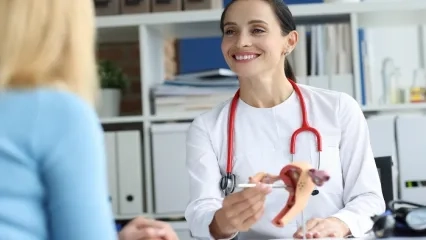Alo Yeditepe
Alo Yeditepe
What Is the Period of Fertility? What Tests are Performed for Fertility?
There may be tests that every couple who wants to bring a child into the world should do. Your fertility is also inversely proportional to your age. What are fertility tests? What are the signs of fertility? Assoc. Dr. Melis Gökçe Koçer Yazıcı conveyed all the information about fertility.
If you and your partner are trying to have a baby but cannot, you may start to wonder if you need to have the necessary tests for your fertility. Experts say that if you are under the age of 35, it is time to consult a physician for 12 months, and if you are over the age of 35, it is time to consult a physician as a result of the fact that pregnancy has not been achieved despite regular sex without birth control for 6 months. Yeditepe University Hospitals Gynecology and Obstetrics Specialist Assoc. Dr. Melis Koçer Yazıcı gave detailed information about fertility tests.
How Do You Know If You Are Fertile?
Couples need to go to the physician together. According to the American Society for Reproductive Medicine, infertility affects men and women equally, so both partners should be tested. They will probably also ask about your overall health and lifestyle at your first meeting with your physician about this.
- Medical history, including chronic diseases or surgeries,
- Medicines you have taken or have taken in the past,
- Smoking, alcohol use, caffeine consumption or illegal drug use,
- Your contact with chemicals, toxins, or radiation at home or work,
- Also, about your sex life.
- The frequency of having have sex,
- Birth control method selection and usage history,
- The presence of sexually transmitted diseases,
- The presence of any problems during the relationship.
Your physician will also ask you the following questions about your menstrual periods, these are;
- Have You Been Pregnant Before?
- How often have you had a period during the past year?
- Have you experienced irregular menstrual periods or menstrual delays?
- Was there any staining between periods?
- Have you had any changes in the amount of your bleeding, such as a change in length, a drop in large blood clots, or pain associated with periods that were not previous?
- Which birth control methods did you use?
- Have you ever been to the physician to have a baby and received any treatment?
What Tests are Performed for Fertility?
There are no single best tests for researching infertility. Physicians use various examinations to identify problems that may cause fertility problems. Other than that, the examinations, and tests to be carried out respectively;
Pelvic Examination and Ultrasound Evaluation
You should have a Pap smear test used to detect abnormal cells around the cervix. The test is useful in detecting cervical cancer and other problems with the cervix or sexually transmitted diseases. Any of these can cause you trouble getting pregnant.
Transvaginal ultrasound evaluation is a non-invasive screening for imaging of the uterus and ovaries. Although it may be a little uncomfortable for some women, it will provide a much better result than an ultrasound of the abdomen. With the transvaginal ultrasound method, while the presence of a structural abnormality such as a polyp, myoma, or fluid accumulation in the tubes, that is, hydrosalpinx, which may prevent pregnancy in the uterus, we can have an idea about egg reserve by looking at the cysts formed in the ovaries and the number of eggs that may develop at the beginning of each menstrual period. In the presence of structural anomalies, it is necessary to verify the current situation by using additional examination and interventional diagnostic methods. Or, if any cystic lesion is observed, imaging methods, blood tests, or even some interventional procedures may be required in cases where the infection is suspected to exclude a malignant condition before conception.
Blood Tests
It is often used to control hormone levels and ovarian reserve (the number of potential eggs remaining in a woman's ovaries). On the second or third day of menstruation, FSH, LH, and E2 hormones are evaluated. TSH and sT4 tests should also be requested to evaluate thyroid gland functions.
Apart from these, if there is a family history of early menopause or ovarian failure, if there is little ovarian reserve as a result of the ultrasound evaluated on the 2-3rd day of menstruation, Anti-Müllerian Hormone (AMH) may be requested to confirm this. While FSH, LH, and E2 hormones should be requested on the 2-3rd day of menstruation, a certain day or hour or fasting is not required for AMH examination. While the AMH test result is evaluated as 1-3 ng/ml normal range, values below <1ng/ml are considered low, and patients are given counseling about having a baby as soon as possible.
Minimally Invasive Procedures such as Surgery
Hysterosalpingogram (HSG) is an imaging method performed by taking an X-ray of your uterus and fallopian tubes after injecting a special dye through the cervix.
After the eggs are laid, they are held with the help of tubes and merged with sperm here. The embryo formed by fertilization of the egg with sperm advances with the movement of the tubes towards the uterus, if there is no obstacle in front of it, and when it comes to the uterine endometrium, it clings if there are appropriate conditions and pregnancy begins to progress. In the event of fluid accumulation in the tubes (hydrosalpinges), obstruction, or any space-occupying lesion in your uterus (myoma, polyp), or adhesion (adhesion, synechiae), progression or adhesion to the uterus cannot occur. We also use HSG imaging to exclude these pathological conditions.
Laparoscopy (closed surgery) is a very comfortable surgical method for the patient and physician, in which the organs in the abdomen (uterus, fallopian tubes, ovaries, intestines, etc.) can be directly seen and examined with a thin tube (laparoscope) with a camera at the end by making a few incisions 1 cm and smaller on the wall of the abdomen, and in case of any pathology, treatment can be applied.
When any blockage or fluid accumulation in the tubes is considered, a dye is given from the cervix and the passage of this dye through the tubes can be controlled and it can be clearly monitored whether there is any obstacle in the path where the embryo is transported. In case of a problem, the same treatment can be applied during the surgery.
What are the Symptoms of Fertility?
In most cases, having a normal menstrual cycle is the most important clue that you are fertile, regardless of your weight. In order to have regular menstruation, it is necessary to select an egg at the beginning of the menstrual period every month and grow and mature, and to remove it from the ovary, that is, to ovulate.
There are some methods that you can follow in your body so that you can understand that you are ovulating;
Tracking the Length of Your Menstrual Cycle
Ovulation usually occurs about 14 days before your period starts, so if you have a regular cycle, you can calculate the average time your egg will be laid. In a 28-day cycle, this means day 14 after the onset of menstruation. On a 32-day cycle, this means the 18th day after the onset of menstruation. But if your cycle is not completely regular from month to month, it is hard to know for sure. So keep a menstrual cycle calendar for several months, or use tools that can help you calculate ovulation.
Mittelschmerz/Ovulation pain
20 percent of women feel pain, ache, or cramp in the lower abdomen or unilateral groin area during ovulation. This German term means "moderate pain", that is, pain due to ovulation in the middle of periods, and some women may also experience mild spotting-style bleeding with this pain.
Quantity and Consistency of Your Cervical Mucus
You might notice a wetter, clearer (like an egg white), and more slippery discharge at the time of ovulation.
Basal Body Temperature (BBT)
In the days after ovulation, if you measure your body temperature with a thermometer without getting out of bed, you can detect a small increase.
The first thing in the morning is the basic body temperature measurement you take with the thermometer after at least three to five hours of sleep and before you get out of bed, talk, or even sit down. As fluctuations in hormone levels occur, your BBT changes throughout your cycle. During the first half of your cycle before ovulation, the hormone estrogen is predominant. In the second half after ovulation, there is an increase in progesterone and your body temperature rises.
As soon as ovulation occurs, your body temperature will rise by about half a degree. Keeping track of your BBT, which should not be forgotten, will not be able to determine the exact day you ovulate, it will be proof that only eggs can be laid.
- Ovulation time hormone (luteinizing hormone-LH) levels increase, and the most likely time can be determined using ovulation prediction kits that measure the hormone level in your urine.
- Your sexual desire may be increased.
- Your vulva or vagina may look swollen.
- Your cervix softens and opens.
It is probably best to use a combination of these methods.
Some women may also experience other symptoms such as tenderness, bloating, and mild abdominal pain in the breasts as they approach ovulation times, but these are not reliable ways to predict ovulation.
What Are the Chances of A Woman Getting Pregnant?
If you're under the age of 35 and have regular sex without using birth control, your chance of getting pregnant within 1 year is 8 out of 10.
How Can You Increase Your Chances of Getting Pregnant?
- Having sex every 2 to 3 days without using birth control,
- Pay more attention to intercourse during ovulation,
- A healthy weight control that suits you, reduces or stops alcohol and does not smoke.
Press Coverage: elele.com
About
Faculty and Year of Graduation:
İstanbul University Faculty of Medicine, 2007
”
See Also
- Contraceptive Methods: Birth Control and Effective Protection Options
- What is Pelvic Floor? What are Their Duties?
- What is Hysteroscopy? Hysteroscopy Usage Areas
- Menopause Symptoms and Menopause Treatment
- How Does Working Life Affect Prospective Mothers?
- Causes of Female Infertility
- Chronic Pelvic Pain
- What is Polycystic Ovary Syndrome/PCOS?
- Postpartum Period
- 7 Effective Tips Against Urinary Incontinence
- Imaging Methods During Pregnancy
- Causes of Male Factor Infertility
- The Effect of Advanced Age on IVF Treatment
- Infertility
- Polycystic Ovary Syndrome
- Early Menopause
- Blocked Fallopian Tube
- Vaginismus
- Low Ovarian Reserve (AMH)
- Which Methods Increase Success in Treatment of Infertility?
- Intrauterine insemination (IUI)
- Microinjection
- Egg Cryopreservation
- Assisted Hatching
- Micro-chip
- Pre-implantation Genetic Diagnosis
- Thyroid Diseases During Pregnancy Affect the Baby as Much as the Mother
- Endometriosis
- Co-Culture
- Ovarian Rejuvenation / PRP
- As Average Life Expectancy Increases, This Problem Will Be Seen More
- Beware, These Risks Increase After Menopause!
- Considerations for Embryo Transfer
- What Causes Menstrual Irregularity, How Is It Treated?
Alo Yeditepe




